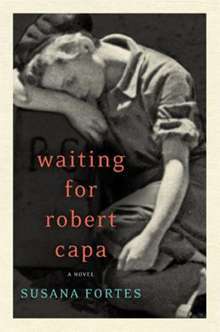 I found this to be a bit of a mixed bag. I certainly couldn’t have picked a more different book to follow my recent reading.
I found this to be a bit of a mixed bag. I certainly couldn’t have picked a more different book to follow my recent reading.
On the plus side, Waiting for Robert Capa is based on a set of real events that I found truly amazing. It had never occurred to me that the famous 20th century war photographer Robert Capa was not a real person, at least not at first.
You might know Capa for what’s been called the most famous war photograph of all time, now called “The Falling Soldier”, in which he captured a loyalist soldier in the Spanish Civil War at the exact moment of his death, arms spread wide, feet moving forward and his head rocked back from a sniper’s bullet.
What you might not know is that Capa was originally a persona invented by a struggling pair of photographers who created a “famous American photographer” to credit their photos to, allowing them to charge much more than for work under their own names.
André Friedmann and Gerta Pohorylle were lovers and refugees from Nazi Germany in the early 1930s, whose talent was recognised but who had trouble making ends meet. Between them, they created “Robert Capa” and the ruse worked so well that André adopted the name as his own and became Robert Capa. Once he was taking all the credit for both their photos, Gerta became Gerda Taro and established her own reputation until the car she was in collided with a tank in Spain in 1937 and she was killed.
Capa went on to become probably the most lauded war photographer in the world, characterised by his daring camera work on the front lines of the Spanish Civil War, at the Chinese resistance to Japanese invasion in 1938, the D-Day landings in WWII (he was among the first landing at Normandy in 1944), and in post war Soviet Union. In 1947, he formed the famous Magnum studio with Henri Cartier-Bresson, and died in 1954 when he stepped on a land mine during the First Indochina War in 1954.
All this is known and well-documented. What Susana Fortes has done in Waiting for Robert Capa is extrapolate from the known facts to explore the couple’s relationship in the context of the turbulent times of mid-20th century Europe.
It is very much a love story, but also a picture of a time when fascism looked like becoming the predominant political philosophy in Europe, even in France. Fortes has created a highly detailed interior life for Gerta / Gerda and her tempestuous relationship with André / Robert. She paints equally detailed word pictures of the physical environment and what life was like for creative people at the time, as well as the emotional landscape inhabited by the two lovers.
This is obviously a very different approach to that taken by Alan Garner and Cormac McCarthy, and I did find it very powerful and moving in dramatic scenes such as when Gerda’s flat is ransacked by fascists, the description of the atrocities at Guernica, and André’s account of the how the famous photo was taken.
Where the book was less successful for me was in describing the visceral physicality of their love. I know sex scenes are difficult to write at the best of times, but I’m afraid these left me rolling my eyes. Your mileage may differ.
I also understand that Fortes was setting the scene, and being historically accurate, but I have rarely encountered a bigger name dropper. It felt like the couple encountered everyone who was a writer, painter, film-maker, musician or – of course – photographer at the time: Hemingway, Joyce, Picasso, Buñuel, Trotsky, Man Ray, Orwell, Piaf, Laurel and Hardy, Matisse, and many more, with referential appearances by everyone from Karl Marx and John Reed to Greta Garbo and Jospehine Baker. I’m sure it’s all true, and I guess it’s indicative of the time and place that they crossed paths with so many famous creatives, but it felt a bit stilted to me.
There were also some odd word choices in the text, like “pinnacle” for “pinochle” and “canons” for “cannons”. This may be a fault of the e-book, I don’t know, but it was annoying.
It could be that the level of physical and emotional description was just a bit overwhelming to me after Treacle Walker and The Passenger but I found myself wishing for a bit of restraint, a little less detail.
Apparently, the film rights have been picked up by Michael Mann, which I guess is a good thing. Maybe giving it the “Miami Vice” treatment will do it good.
Overall, I thought Waiting for Robert Capa was a great story and quite daring in its bold depiction of real people and events, albeit a bit over-written. And it’s only 136 pages, so you may find it worth a read.